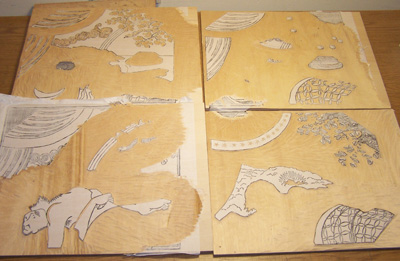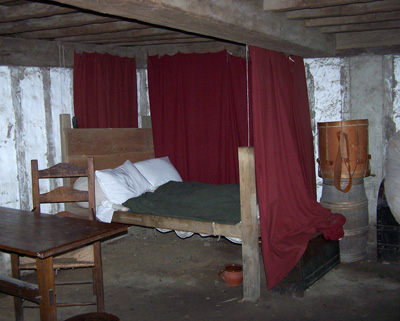Today's postings
- [Baren 39113] Paper Recommendations (Gayle Wohlken)
- [Baren 39114] paper (Cucamongie # aol.com)
- [Baren 39115] paper, p.s. (Cucamongie # aol.com)
- [Baren 39116] Re: paper, p.s. ("Louise Cass")
- [Baren 39117] Exchange 41 (josepht280 # aol.com)
- [Baren 39118] Re: paper choices (J Cloutier)
- [Baren 39119] Re: paper choices (Graham Scholes)
- [Baren 39120] Baren Member blogs: Update Notification (Blog Manager)

Message 1
From: Gayle Wohlken
Date: Tue, 16 Jun 2009 14:04:27 GMT
Subject: [Baren 39113] Paper Recommendations
Send Message: To this poster
about? I don't do moku hanga, but my all-time favorite for black
prints, and even for color work is Kitakata. This is how it is
described:
"Kitakata is manufactured from mitsumata. Mitsumata fibers produce a
soft, smooth surface with a natural gloss. The silky touch makes this
paper a favorite.
Sheets measure 16" × 20" (approximately 40.5 cm × 51 cm), and are
sized and acid-free, with deckle edges. Weight is 30 gsm."
One thing I find interesting about the above description from Blick is
that I never thought kitakata paper was sized. I don't think it must
be sized very much.
Anyway, for black ink work, I like it very much. I don't like pure
white paper, and the natural tone of this paper seems to make the
image more attractive. I also like the way the image comes through on
the back so you can see what you are doing when hand burnishing. It's
a strong paper, but sometimes there are little nubs in it that can
tear if you aren't careful. If you see those, I recommend using a
piece of parchment paper over that area. Whenever I've been lazy and
not used the parchment, I've been sorry. I've ruined a couple
beautiful prints by not following my own advice.
~Gayle

Message 2
From: Cucamongie # aol.com
Date: Tue, 16 Jun 2009 14:50:57 GMT
Subject: [Baren 39114] paper
Send Message: To this poster
thanks for sharing!
for hanga:
once in a while when I can use expensive paper, I would spring for
Yamaguchi -- it prints very easily and holds the color really well. Like Mike
said, it is somewhat sparkly but I don't have a problem w/that!
If I need to use cheaper paper (which is most of the time) I have found
that Stonehenge works very well, particularly if you have a ball bearing baren
on hand, as you have to press down hard (or sometimes do multiple
printings) for the color to transfer.
Another cheapo paper I have used that works well is hanga-shi, which I get
from Hiromi Paper. It is yellowy in color though so you have to want that
look. I printed my Self-Portrait/Tree print on that most recently.
As for inks, I use Guerra Pigments and Akua Kolor. The Akua Kolor can get
a bit sticky (it has honey in it) but I have found the colors to be nice
and bright. Generally I use Guerra pigments for the more earthy colors, as
some of these types of color in the Akua Kolor (at least in the older
mixtures I have) can be a bit thin in texture, and Akua Kolor or Guerra for the
brighter colors, as either one of these have worked well for me.
Sarah

Message 3
From: Cucamongie # aol.com
Date: Tue, 16 Jun 2009 15:21:42 GMT
Subject: [Baren 39115] paper, p.s.
Send Message: To this poster
frequently used Nishinouchi for hanga printing. It doesn't print as
easily as the hosho, but it is a very nice paper that is in between in price
between the hosho and the cheap papers like Stonehenge, Rives Heavyweight and
Hanga-Shi.

Message 4
From: "Louise Cass"
Date: Tue, 16 Jun 2009 16:35:20 GMT
Subject: [Baren 39116] Re: paper, p.s.
Send Message: To this poster
Louise C.

Message 5
From: josepht280 # aol.com
Date: Tue, 16 Jun 2009 21:13:08 GMT
Subject: [Baren 39117] Exchange 41
Send Message: To this poster
Whew! I hope your month has been better than mine. In 48hrs I lost a parent to natural causes, my youngest had a substantial car accident (she walked away) that we happened upon while driving back from dinner celebrating my wife's birthday! And my dog hiked his leg on our new HD tv and shorted it out. And this morning my neighbor told me she saw a rat go under my back porch. Not to mention the letter from the IRS and my mortgage lender. And it seems that that is only the beginning. So I have a list of things to take care of but I'm still working on my woodcut for exchange 41. There have been several drops from the list so please check to see who is off the waiting list. If you haven't let me know you are "IN" please email me atcoordinator41@barenforum.orgso I know that your email address is working and that the list is current. And to be fair, let me know ASAP if you find that you have to drop out so that others will have sufficient chance to work on their prints.
Thank you so much for your work to make this a success.
Joe Taylor

Message 6
From: J Cloutier
Date: Tue, 16 Jun 2009 21:34:25 GMT
Subject: [Baren 39118] Re: paper choices
Send Message: To this poster
about it, since it's a cheaper paper. But I've had the same experience
as you - I used shin torinoko for my proofs, and torinoko or Rives for
my prints - and ended up liking the proofs better. The colors seemed
livelier and clearer. I'm using only shin torinoko for my exchange 41
prints. (Pulling proofs this weekend!)
Jane Cloutier

Message 7
From: Graham Scholes
Date: Tue, 16 Jun 2009 21:54:32 GMT
Subject: [Baren 39119] Re: paper choices
Send Message: To this poster
The stuff I am aware of is not.
Graham
Digest Appendix
Postings made on [Baren] members' blogs
over the past 24 hours ...
Subject: Baren Ads & Ops June 15, 2009
Posted by: Julio
|
Welcome to the Baren Ads & Ops Newsletter Training Moku Hanga DVD
Japanese Woodblock: Moku Hanga SANTA CRUZ Class dates (Class #01CAMH1-05) are: Sat. & Sun., August 23 & 24, 10:00 am to 4:00 pm |
This item is taken from the blog BarenForum Group Weblog.
'Reply' to Baren about this item.
Subject: Color Plates Carved
Posted by: Annie B
 I've carved four plates for the colors, so I'm ready to start printing "American Bible Story" tomorrow. I've been alternating between Nishinouchi paper and Echizen Kozo for this series depending on what effect I'm looking for. I like the rich off-white tone of the Nishinouchi and it makes these Pilgrim prints look "old," but I don't think it holds up as well under many many impressions. I did the Dorothy May Bradford print on Echizen Kozo because I thought it would take the overprinting inks better, but I think I'll use Nishinouchi for this print. I'm also thinking about printing the keyblock differently. When I printed the proofs I liked the effect made by printing with etching ink and I may try doing this keyblock with Akua etching ink on top of the moku hanga style color blocks. The advantage I see to this is that the keyblock would stay dry, so the thin lines wouldn't swell as they do with the hanga method. My trip to Plymouth last weekend was pretty interesting. Lynn and I weren't too enamored of the town itself and our hotel was...hmmm, how shall I say this...not too pleasant, but we spent a lot of time at Plimoth Plantation and learned a lot. I've been imagining the "curtain" in my new print as a kind of cranberry red color so I was amused to see this interpretation of John Alden's bed at Plimoth Plantation:  And another view of the one-room dwelling: [Long item has been trimmed at this point. The full blog entry can be viewed here] |
This item is taken from the blog Woodblock Dreams.
'Reply' to Baren about this item.